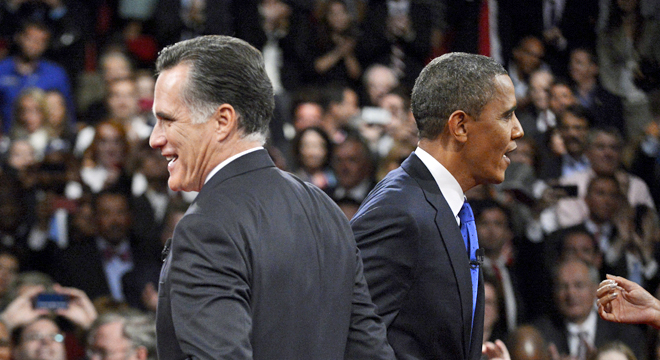How tight is the presidential race in Ohio? It depends who’s polling.
Surveys of the Buckeye State have been all over the board in recent weeks as the election draws near. While most show President Obama with the lead, the size of it depends on whether the pollster was using human beings or robots to do the interviewing.
TPM compared the two methods and found that polls conducted by a live interviewer, the method widely considered to be the gold standard, have shown the President with larger leads than polls conducted by automated calls, which are prohibited from contacting people through cell phones. Since early September, live polls have shown Obama with an average lead of 4.5 percentage points in Ohio while his average lead in robo-polls has been less than 2.
Ohio has been the most polled state of the presidential campaign since the national conventions, edging both Florida and Virginia for that distinction. The 44 polls conducted there since the conclusion of the Democratic National Convention on Sept. 6 include 22 done by automated calling, 16 performed by live phone interviews, five conducted online and one based on mail-in responses.
The chart below looks at Obama’s leads in live polls compared to the robo-polls since the end of the DNC last month. Any dip below 0 percent represents a lead for Republican nominee Mitt Romney:
The live polls showed Obama with a much bigger post-convention bounce in September than the robo-polls did. His biggest lead was 10 points in a live survey conducted Sept. 18-24 by Quinnipiac University, CBS News and the New York Times.
Conversely, the robo-polls were much more reactive to Romney’s rise following the first debate on Oct. 3 in Denver. Obama’s average lead in the 15 automated surveys conducted in Ohio after the debate dwindled to less than a point. Romney led in just five surveys in the weeks following that debate. Four of them were robo-polls.
Charles Franklin, the director of the Marquette University Law School Poll and co-founder of Pollster.com, explained that surveys conducted by live callers remain the preferred method because they are able to reach a more accurate sample of voters.
Part of that, he said, is because unlike robo-polls they are allowed to call cell phones as well as landlines. (Robo-polls are legally prohibited from calling cell phones.) Another reason is that voters are more likely to answer questions from a real person than a pre-programmed recording. That means live polls will sample not just the enthusiastic voters, but also some who are in the middle of the road.
“The response rates to automated polls are naturally a good deal lower than live interview polls. Both have low response rates, but automated are quite a bit less,” Franklin told TPM. “The lower the response rate, the more likely you are to get a more involved, interested and motivated sample. That shows up in a higher probability of voting, but might show up with lower undecideds.”
Because robo-polls can only contact landlines, they also have a reputation for skewing older, whiter and less Democratic. But Doug Usher, a pollster for John Kerry’s 2004 presidential campaign and managing partner at Purple Strategies, which uses robo-polls, told TPM that a “well-crafted automated poll can make up for some of the age and minority gaps.” He pointed to online surveys designed to capture voters who only use cell phones.
Nevertheless, Franklin said that automated pollsters will have no choice but to find a way to include a more representative share of what is a growing segment of the electorate. The Gallup organization picked up on this trend earlier this month, increasing the portion of cell phone users in the sample of its daily tracking poll to 50 percent.
“The number of cell phone only users in the population is only going up,” Franklin said.
Still, automated polls have grown ubiquitous over the last few election cycles, and their appeal is easy enough to understand. They represent a more economical option than live polls, which necessitate more manpower. Robo-polls also enable organizations to conduct “snap surveys” in one night. Two of the automated polls included in the data above were conducted the day immediately following the first debate.
Charles Franklin is a consultant to TPM’s PollTracker
Chart by TPM’s Christopher O’Driscoll






